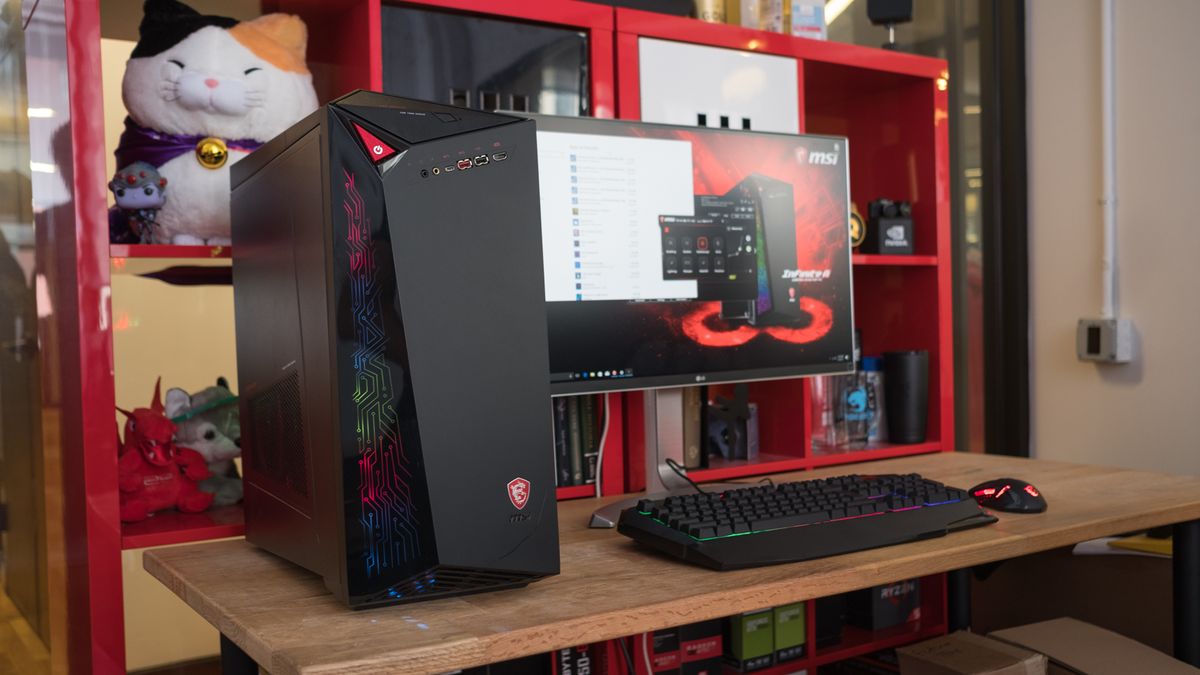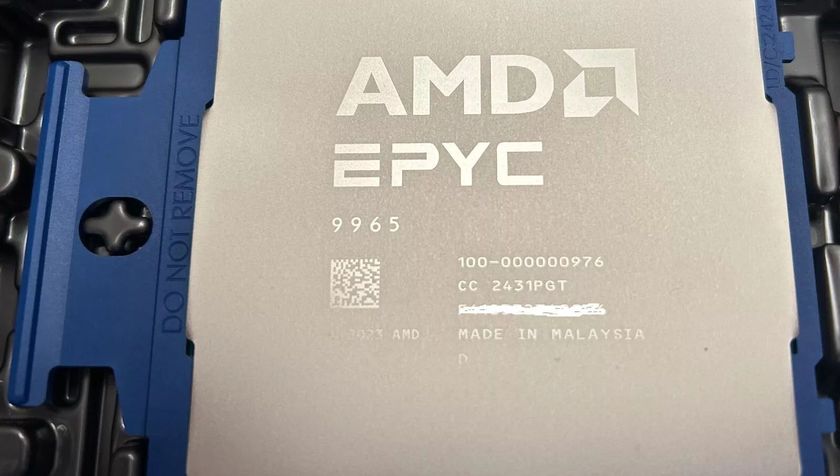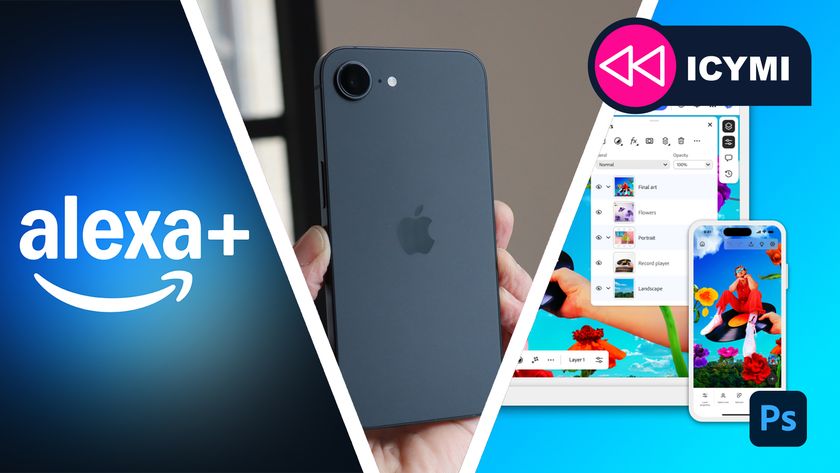TechRadar Verdict
The MSI Infinite A can chew up practically any game you throw at it. Just try not to let all the features confuse you.
Pros
- +
Very powerful gaming system
- +
Whisper quiet fans
- +
Exceptional variety of features
Cons
- -
Variety of ports can be confusing
- -
High specs mean high price tag
- -
Virtual surround sound isn’t great with stereo speakers
Why you can trust TechRadar
The MSI Infinite A is built from the ground up for a broad range of PC gaming demands. It fits the bill whether you’re in the market for a high-powered gaming rig for smooth frame rates or looking to jump in VR.
In fact, it takes being VR-ready to a whole new level with dedicated front-facing HDMI and USB 3.1 ports, making it easy to plug in headsets such as the Oculus Rift or HTC Vive. But even if you don’t own a VR headset, the Infinite A is more than capable of handling almost all of the hottest games with the settings cranked all the way up.

Here is the MSI Infinity A configuration sent to TechRadar for review:
CPU: 3.6Ghz Intel Core i7 7700 (quad-core, 8MB cache, up to 4.2Ghz))
Graphics: Nvidia GeForce GTX 1080, 8GB GDDR5X
RAM: 16GB DDR4 (2,400Mhz)
Motherboard: MSI B250M Bazooka (MS-7A70)
Power Supply: 550W
Storage: 512GB M.2 SSD
Optical drive: DVD Super Multi
Ports: 2x USB 3.1 C; 4x USB 3.1; 3x USB 2.0; HDMI; DVI; 3x DisplayPort; VR Link HDMI; gigabit ethernet; mic jack; headphone jack; speaker port; line-in; surround sound audio jacks
Connectivity: Intel AC3168 802.11ac; Bluetooth 4.2
Operating system: Windows 10 Home 64-bit
Camera: None
Weight: 33 pounds (15 kg)
Size: 8.27 x 17.71 x 19.21 inches (W x D x H)
Pricing and availability
Although it isn’t necessarily in the same class as MSI’s hulking Aegis series – which can go for almost $2,000 or more – the Infinite A offers excellent gaming performance at a comparatively modest price of around $1,799 (about £1,389, AU$2,292). Our configuration is essentially the same as the retail SKU, except the Infinite A we reviewed lacks an 2TB hard drive to act as a companion to the 512GB SSD.
That price is significantly higher than the Lenovo Ideacentre Y900, which is similarly equipped, except the Infinite A leans more heavily toward VR and features a newer Kaby Lake processor. The Ideacentre also happens to be significantly more expensive, costing $2,049 (£1,929, AU$3,999) for similar hardware.
Gamers might be able to get by with less expensive systems such as the Dell XPS Tower Special Edition, which starts at about $1,049 (about £800, AU$1,325) and is more of an entry level VR system that uses an Nvidia GeForce GTX 1070 card coupled with an Intel Core i5 CPU and 8GB of memory – but the Infinite A’s beefier specs make it more futureproof.
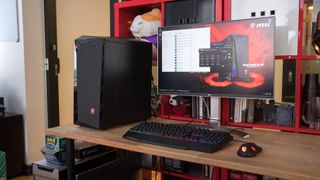
Inside the Infinite A is a 3.6Ghz Core i7 processor with 16GB of memory, which are base standards for the model. You could save a money by choosing Nvidia GTX 1070 graphics, which can handle both VR applications and gaming very nicely, or you can kick things up in the other direction by going with a MSI GTX 1080 Ti 11GB GDDR5 for extreme graphics performance.
With an Nvidia GeForce GTX 1080, our review configuration falls in the middle. Although $1,800 is on the high side for a gaming rig, it is reasonably priced given its weight class and the fact that it has an Nvidia GTX 1080 video card. The SteamVR performance test gives the Infinite A its best score, which almost guarantees a smooth VR experience.
It’s also no slouch when it comes to traditional gaming. Graphics-intensive role-playing games such as Hellblade: Senua's Sacrifice with its highest settings at 1080p played at over 100 frames per second (fps). Meanwhile, twitch shooters such as Overwatch and LawBreakers play at incredibly fast speeds and smooth frame rates. The latter two titles are especially fitting for this system, since the included keyboard and mouse are practically built for first-person shooters.





Design
Although the towering Infinite A desktop might not look it, it’s remarkably light at 33 pounds (15 kg) and it even has a grab handle for relatively easy transport. Its size does push the idea of portability, but you can bring it to rooms and events using one arm.
Essentially, the Infinite A is all about balancing speed with style. The customizable RGB lighting on the left side of the tower, its gaming keyboard and mouse makes it stand out as a gaming rig. It’s less intimidating than the Lenovo Ideacentre (which almost looks like a Cylon designed it) and more stylish than the minimalistic Dell XPS Tower.
However, it’s the Infinite A’s more subtle features that deserve attention. These include the front facing VR ports and its two USB 3.1 C ports (one in front, the other in back) that should be of particular interest to technology enthusiasts. The graphics card is also mounted standing up to show off your components and plays into the cooling system that stays whisper quiet even after hours of intense gameplay.
These are both features you won’t find on most mainstream gaming PCs including Asus and Alienware.
Furthermore, the Infinite A includes virtual surround sound capabilities powered by Nahimic technology. We didn’t really notice its effects with a two-speaker setup, but the audio is more impressive when wearing stereo headphones.



Upgradability
Users have some flexibility with the storage options, going with SSD and HDD combinations or they can boost HDD-only performance over time using an Intel Optane cache drive if they can’t afford SSDs.
Luckily, every retail version is better than the configuration reviewed here, which has a single 512GB SSD partitioned in half. There’s only enough space to install a small handful of games after the recovery partition and the Windows 10 operating system take their share of drive. But in all fairness, those game did load very quickly.
Here’s how the MSI Infinite A performed in our suite of benchmark tests:
3DMark: Sky Diver: 36,143; Fire Strike: 17,061; Time Spy: 6,912
Cinebench CPU: 874 points; Graphics: 135 fps
GeekBench: 5,066 (single-core); 17,338 (multi-core)
PCMark 8 (Home Test): 4,466 points
Deus Ex: Mankind Divided: 1080p, Ultra): 21 fps; (1080p, Low): 148 fps
Total War: Warhammer (1080p, Ultra): 112 fps; (1080p, Low): 232 fps
Performance
When you get down to it, the MSI Infinite A offers outstanding performance without going too far overboard, getting you in games quickly with no muss or fuss… well, not a lot of fuss, anyway. There is an extra HDMI port on the back of the system for use with VR that’s switched on using software tools. It’s very easy to confuse it for the main HDMI connector, which is what happened when we initially set the computer up.
The Infinite A matches very closely with the Lenovo Ideacentre Y900, except that some configurations use an older Skylake processor. So, it’s no surprise that the Infinite A outpaces it in multiple tests (there’s a 1,571 point difference in GeekBench multi-core test alone).
However, the two systems matched each other very closely with day-to-day use benchmarks such as PCMark 8.
What is surprising is the difference in performance when compared to the Dell Tower Special Edition and its GeForce GTX 1070 video card. The Infinite A did significantly better in almost every benchmark area, gaming or not.
For example, MSI scored 12,000 points better than Dell in Sky Diver, 951 points better in PCMark 8, and is faster by 27fps according to the Cinebench graphics test. The results could be due to the fact that the Dell features a Core-i5 processor and 8GB of memory compared to the Infinite A’s Core i7 and 16GB.
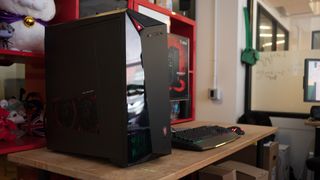
Final verdict
The MSI Infinite A might have a few minor quirks, with all the extra ports and the single SSD drive, but there’s not a whole lot to complain about once the system is up and running. With the fast processor, GTX 1080 video card and 16GB of memory, there’s very little that this gaming PC can’t handle, including VR and 4K gaming.
The high-end hardware might be at a premium just shy of $2,000 to match, but that’s to be expected. The bottom line is that the MSI Infinite A is a near perfect choice for a pre-built gaming rig. Just try not to get lost among all the features.
Most Popular





